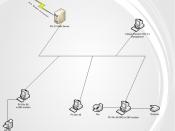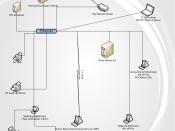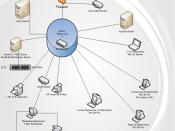Huffman Trucking � PAGE \* MERGEFORMAT �1�
Running head: HUFFMAN TRUCKING NETWORK ANALYSIS
Huffman Trucking Network Analysis
University Of Phoenix
March 1, 2009
�
Huffman Trucking Network Analysis
Huffman Trucking was founded by K. Huffman in 1963. The Company has hubs located in Los Angeles, California, Bayonne, New Jersey, and St. Louis, Missouri with its central facility located in Cleveland, Ohio. "Huffman's primary customers include the U.S. Government, automotive parts suppliers to major manufacturers, electronic consumer products, raw materials (polymer) for manufacturers of plastic products, and any customer requiring special accommodations, such as wine, computers, and munitions" (Facts About Huffman Trucking, 2009). According to Webopedia (2008), the Open System Interconnection (OSI), model defines a networking framework for implementing protocols in seven layers. This paper will discuss Huffman's data network and how layers three through seven of the OSI Model are used within the network.
Located at Huffman's various offices and plants were several servers, workstations, and an Ethernet connection.
The first location that will be discussed is California office, which had an IIS 4.0 Web Server along with four workstations. Microsoft created the internet based service for servers, formally known as Internet Information Services (IIS). A web server program operates by accepting HTTP requests providing a response both from and to the client. These workstations share a HP 5P printer, a scanner, and a fax machine. The server at this location had an internet connection via an AOL modem or dial up, which was indicated by two workstations that had 28K modems installed according to the diagrams provided from the University's website. This location does not have a firewall setup.
The California plant displayed three servers, a Microsoft Exchange 5 Server, Win 2000 Server, and a Proxy Server 2.0 along with 60 workstations, which were connected via an Ethernet connection.


